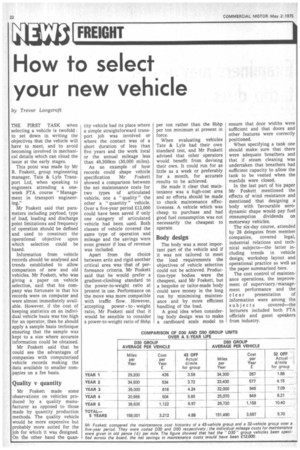ASW
Page 24

If you've noticed an error in this article please click here to report it so we can fix it.
FREIGHT
How to select your new vehicle
by Trevor Longcroft
THE FIRST TASK when selecting a vehicle is twofold to set down in writing the objectives that the vehicle will have to meet, and to avoid becoming involved in mechanical details which can cloud the issue at the early stages.
This point was made by Mr R. Foskett, group engineering manager, Tate & Lyle Transport Ltd, when speaking to engineers attending a oneweek FTA course "Management in transport engineering."
Mr Foskett said that parameters including payload, type of load, loading and discharge point limitations and frequency of operation should be defined and used to construct the operational objective upon which selection could be based.
Information from vehicle records should be analysed and trends established to allow comparison of new and old vehicles. Mr Foskett, who was giving a paper on vehicle selection, said •that his company was fortunate in that his records were on computer and were almost immediately available. However, if the cost of keeping statistics on an individual vehicle basis was too high for an operator, then he should apply a sample basis technique ensuring that the sample was kept to a size where accurate information could be obtained.
Mr Foskett said that he could see the advantages of companies with computerised vehicle records making the data available to smaller companies on a fee basis.
Quality v quantity
Mr Foskett made some observations on vehicles produced by a quality manufacturer •as opposed to those made by quantity production methods. The quality vehicle would be more expensive but probably more suited for the job for which it was designed. On the other hand the quan
tity vehicle had its place where a simple straightforward transport job was involved or where the contact was of a short duration of less than five years and the work local or the annual mileage less than 48,300km (30,000 miles).
As an example of how records could shape vehicle specification Mr Foskett showed a comparison between the net maintenance costs for two types of articulated vehicle, one a " quality " the other a " quantity" vehicle. Over a five-year period £12,000 could have been saved if only one category of articulated vehicle had been used. Both classes of vehicle covered the same type of operation and mileage and the savings were even greater if loss of revenue was included.
Apart from the choice between artic and rigid another critical area was that of performance criteria. Mr Foskett said that he would prefer a gradient-climbing standard to the power-to-weight ratio at present in use. Performance on the move was more compatible with traffic flow. However, accepting power to weight ratio, Mr Foskett said that it would be sensible to consider a power-to-weight ratio of 8bhp per ton rather than the 6bhp per ton minimum at present in force.
When evaluating vehicles Tate & Lyle had their own standard test, and Mr Foskett advised that other operators would benefit from devising their own. It could run for as little as a week or preferably for a month, for accurate results to be achieved.
He made it clear that maintenance was a high-cost area and so efforts should be made to check maintenance effectiveness. A vehicle which was cheap to purchase and had good fuel consumption was not necessarily the cheapest to operate.
Body design
The body was a most important part of the vehicle and if it was not tailored to meet the load requirements the objectives of vehicle selection could not be achieved. Production-type bodies were the cheapest, said Mr Foskett, but a bespoke or tailor-made body could save money in the long run by minimising maintenance and by more efficient handling of the load.
A good idea when considering body design was to make a cardboard scale model to ensure that door widths were sufficient and that doors and other features were correctly positioned.
When specifying a tank one should make sure that there were adequate breathers and that if steam cleaning was undertaken that breathers had sufficient capacity to allow the tank to be vented when the manlids were closed.
In the last part of his paper Mr Foskett mentioned the effects of wind resistance and mentioned that designing a body with 'favourable aerodynamic shape would pay fuel consumption dividends on motorway vehicles.
The six-day course, attended by 28 delegates from member companies, covered legal, industrial relations and technical subjects—the latter including trends in vehicle design, workshop layout and operational practice as well as the paper summarised here.
The cost control of maintenance operations, the improvement of supervisory/management performance and the clear presentation of information were among the subjects covered—the lecturers included both FTA officials and guest speakers from industry.
























































































































